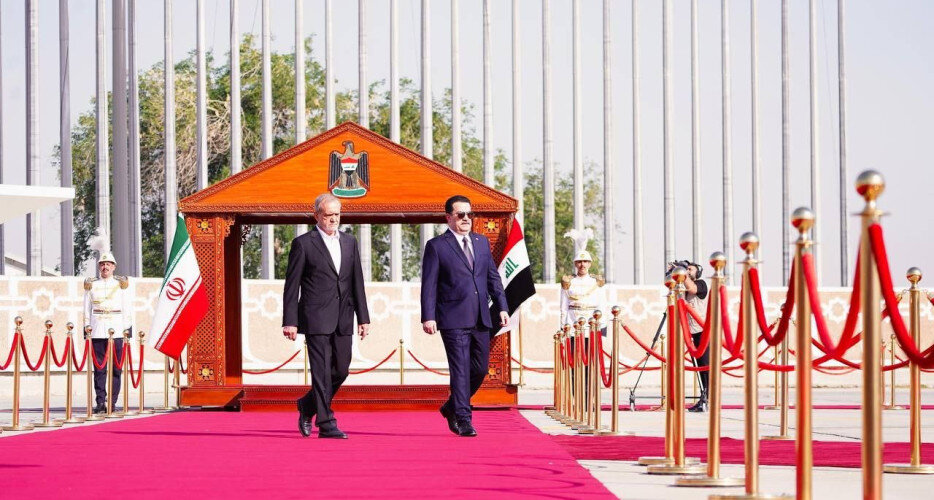Why Iraq matters to Iran
MADRID – Iranian President Masoud Pezeshkian made his first official visit to Iraq since taking office. On the first day of his trip, Pezeshkian held individual meetings with Iraq’s President, Prime Minister, Chief Justice, leaders of the Coordination Framework of Iraq’s Shiite forces, and the First Deputy Speaker of Iraq’s Parliament. Additionally, he met with

MADRID – Iranian President Masoud Pezeshkian made his first official visit to Iraq since taking office. On the first day of his trip, Pezeshkian held individual meetings with Iraq’s President, Prime Minister, Chief Justice, leaders of the Coordination Framework of Iraq’s Shiite forces, and the First Deputy Speaker of Iraq’s Parliament. Additionally, he met with Iranian expatriates in Baghdad and participated in discussions with business leaders active in Iraq.
On the second day, the President of the Islamic Republic of Iran traveled to Erbil and Sulaymaniyah for talks with officials from the Kurdistan Regional Government. He also visited the holy cities of Najaf and Karbala, where he paid respects at the sacred Shiite shrines.
This visit underscores Iraq’s geopolitical and geoeconomic importance to the Islamic Republic. This article aims to shed light on the recent relations between the two countries and analyze Iraq’s significance to Iran’s security and regional stability. In this regard, it is crucial to recognize that the convergence between the Islamic Republic of Iran and Iraq and their bilateral relations can impact regional security, potentially enhancing security levels and mitigating regional challenges.
Iran’s foreign policy strategy toward Iraq after the fall of Saddam Hussein has been shaped by various factors, including geography, economics, and its role within the Axis of Resistance. This strategy, developed in the context of the U.S. occupation of Iraq, the dissolution of the Iraqi government and military, and the shifting perspectives of regional actors, has progressively expanded Iran’s regional and global influence in post-Saddam Iraq.
Following Saddam’s fall, Iran’s foreign policy contributed to the formation of security in Iraq, a nation engulfed in crises after the Ba’ath regime’s collapse and the military’s dissolution. Iran played a pivotal role in establishing Iraq’s new security framework, including both physical and cyber security. However, the involvement of other regional powers, such as Saudi Arabia, has introduced new security challenges for Iraq.
Iran’s foreign policy in the post-Saddam era has undergone significant transformations, distinguishing itself from earlier approaches. Over the years, Iranian leadership has focused on implementing measures to balance the country’s foreign policy, resulting in active diplomacy in Iraq, which was previously unattainable. Between 2003 and 2014, no agreement was reached to balance regional powers in Iraq, contributing to the country’s ongoing instability.
Iraq’s parliamentary system, its Shiite majority, and Iran’s strong ties with Iraq’s Shiite population, alongside the withdrawal of U.S. troops and the Syrian crisis, have allowed Iran to maintain significant influence and strategic relations during the last three Iraqi elections. In contrast, Turkey and Saudi Arabia have not achieved similar success in Iraq’s parliamentary elections.
The U.S. invasion in 2003 and Saddam’s fall marked a critical juncture in Iraq’s history, releasing pent-up energy within the country. The emergence of new ideas, groups, and figures, along with the influence of regional and non-regional actors, rapidly reshaped Iraq’s internal dynamics. Although the withdrawal of U.S. forces eased tensions somewhat, the rise of ISIS further exacerbated the wounds inflicted by decades of dictatorship and occupation, compounding Iraq’s devastation and challenges.
In recent years, particularly after the defeat of ISIS, Iraq’s foreign policy behavior has shown notable developments. Changes in Iraq’s power and governance structure have facilitated the influence of regional actors like Iran. The key question remains: What policy has the Islamic Republic of Iran adopted toward Iraq post-Saddam, and what are its objectives?
Before addressing these issues, it is essential to first define the Islamic Republic as a regional power. In general terms, a regional power can be characterized by meeting, to a greater or lesser extent, the following criteria:
1- Power Resources: Possessing essential resources of power, particularly an effective military force.
2- Regional Pole: Being one of the centers of power within the region.
3- Cultural and Normative Influence: Having the ability to shape and establish norms and cultural trends in the region.
4- Impact on Regional Trends: Influencing the development of events and crises within the region.
5- Crisis Management Capability: Being able to form and manage regional crises.
6- Special Status in Foreign Policy: Holding a special status in foreign policy at both regional and transnational levels.
7- Participation in Regional Order: Contributing to the creation and maintenance of regional order.
8- Influence in Regional Interactions: Impacting regional interactions and relations.
9- Defensive Capability: Maintaining the ability to defend against other countries in the region.
A regional power must not only show interest in the affairs of its region but also intervene effectively in the resolution of regional crises when necessary. This intervention should be accompanied by an influential capacity. Major regional problems cannot be solved without the involvement of a regional power, which must demonstrate its commitment to leadership and act as a stabilizing force in the region. According to this view, the Islamic Republic of Iran can be defined as a regional power.
From a geopolitical perspective, two primary objectives of Iran can be outlined:
1. Eliminating Threats and Creating New International Dynamics:
A key objective of Iranian foreign policy is to reduce threats surrounding the Islamic Republic and to establish new international trends that enhance its stability and security.
2. Creating Mutual Opportunities and Expanding Strategic Depth:
Iran aims to create new opportunities for cooperation while expanding its influence and strategic depth in the region and beyond, thereby strengthening its position on the international stage.
In addition to these immediate priorities—eliminating threats and creating opportunities—Iran must implement long-term mechanisms. These mechanisms include cultural strategies, economic and commercial tools (such as joint investments), and the strengthening of public diplomacy in the region. The goal is to achieve a position where Iran can define its foreign policy influence, with a focus on increasing the strategic depth of the Islamic Republic in the region.
Iran’s political priorities concerning Iraq after Saddam Hussein’s fall can be defined as follows:
1. Friendly Relations and Peaceful Coexistence:
Relations between Iran and Iraq faced challenges even before the Islamic Revolution. Saddam Hussein’s invasion of Iran and the subsequent eight-year war emphasize the need for establishing friendly relations as a key priority for Iran.
2. Security and Stability in Iraq:
Sharing a 1,500-kilometer border, Iran views Iraq’s security and stability as integral to its own. Instability in Iraq directly affects Iran’s internal security, making the maintenance of Iraq’s stability a second priority for Iran.
3. Preservation of Iraq’s Territorial Integrity and Prevention of Fragmentation:
Iran is sensitive to any possibility of Iraq’s fragmentation. Despite proposals to divide Iraq into three countries (Shiite, Sunni, and Kurdish), Iran remains committed to safeguarding Iraq’s territorial integrity.
4. Eradication of Terrorism:
The presence of takfiri terrorist groups in Iraq poses a major threat to Iran’s national security. Iran has invested significant resources in combating terrorism in Iraq, considering it a fundamental priority.
5. Ratification of the 1975 Border Treaty:
Border disputes between Iran and Iraq were partly resolved with the signing of the 1975 Algiers Agreement. Consolidating and continually enforcing this agreement is essential for maintaining stability and friendly relations between the two countries.
6. Opposition to U.S. Military Presence in Iraq:
Iran opposes the U.S. military presence and dominance in the region, particularly in Iraq. Since the U.S. invasion and the ongoing military presence post-ISIS, Iran has consistently expressed disagreement with this policy.
7. Strengthening Cultural and Islamic Ties:
Iran and Iraq have shared centuries of close cultural and Islamic ties. Tens of thousands of citizens from both countries have family connections, and six Shiite shrines are located in Iraq. Najaf, historically a center of Shiite religious authority, is of particular importance. Deepening these ties is a critical priority for Iran.
8. Long-Term Collective Cooperation in the Persian Gulf:
Stable and collective cooperation in the Persian Gulf is vital. Iraq must maintain friendly relations not only with Iran but also with Saudi Arabia and other Arab countries. The security and stability of the Persian Gulf largely depend on harmonious relations between Iran, Saudi Arabia, and Iraq. Without strong cooperation among these regional powers, sustainable security will remain elusive.
Iran’s balanced foreign policy in Iraq following the defeat of Daesh has had several significant impacts:
Increased Regional Stability:
Iran’s intervention has contributed to greater stability in Iraq. By supporting the Iraqi government in its fight against Daesh and aiding in post-conflict reconstruction, Iran has helped prevent the resurgence of extremist groups and strengthened Iraq’s central government.
Strengthened Bilateral Relations:
Iran’s balanced foreign policy has strengthened ties between the two countries. Cooperation on security issues and infrastructure reconstruction has forged a strong strategic relationship based on common interests and shared threats.
Expanded Regional Influence:
Iran has used its role in stabilizing Iraq to expand its influence in the region. By closely collaborating with Iraq on reconstruction and security, Iran has solidified its position as a key player in regional politics, advancing its geopolitical interests.
Challenges and Tensions:
Despite these benefits, Iran’s presence in Iraq and its support for certain groups have sparked tensions with other regional actors, including some Arab states and the U.S. Carefully managing these relationships has been essential for maintaining balance.
Progress in Reconstruction and Development:
Cooperation in Iraq’s reconstruction has led to significant advances in the country’s economic and social development. Joint projects and investments have revitalized infrastructure and improved living conditions in areas affected by conflict.
In summary, Iran’s balanced foreign policy in post-Daesh Iraq has had a substantial impact on both stability and bilateral relations, though it has also presented challenges requiring careful management to maintain positive regional balance.
The U.S. invasion of Iraq and the fall of Saddam Hussein marked the beginning of a series of transformations that not only redefined Iraq’s power and politics but also reshaped the landscape of power, politics, security, and foreign relations across the Middle East. Given that Iraq’s future governance and bilateral relations directly affect Iran’s foreign policy, this policy formulation can be seen as Iran’s strategic entry into the regional and global arena.
Indeed, the Islamic Republic of Iran’s foreign policy toward Iraq has bolstered its role as a key regional power. The optimal foreign policy strategy for Iran in the new Iraq, considering Iran’s elevated regional position and the recent changes in both regional and global contexts, is crucial. The fall of the Ba’ath regime and subsequent transformations marked a turning point in relations between the two countries.
President Pezeshkian’s visit to Iraq underscores the Arab country’s importance and the necessity of maintaining a good-neighbor policy that not only strengthens Iran’s regional role but also provides the necessary stability to the region.
source
برچسب ها :
ناموجود- نظرات ارسال شده توسط شما، پس از تایید توسط مدیران سایت منتشر خواهد شد.
- نظراتی که حاوی تهمت یا افترا باشد منتشر نخواهد شد.
- نظراتی که به غیر از زبان فارسی یا غیر مرتبط با خبر باشد منتشر نخواهد شد.






ارسال نظر شما
مجموع نظرات : 0 در انتظار بررسی : 0 انتشار یافته : 0